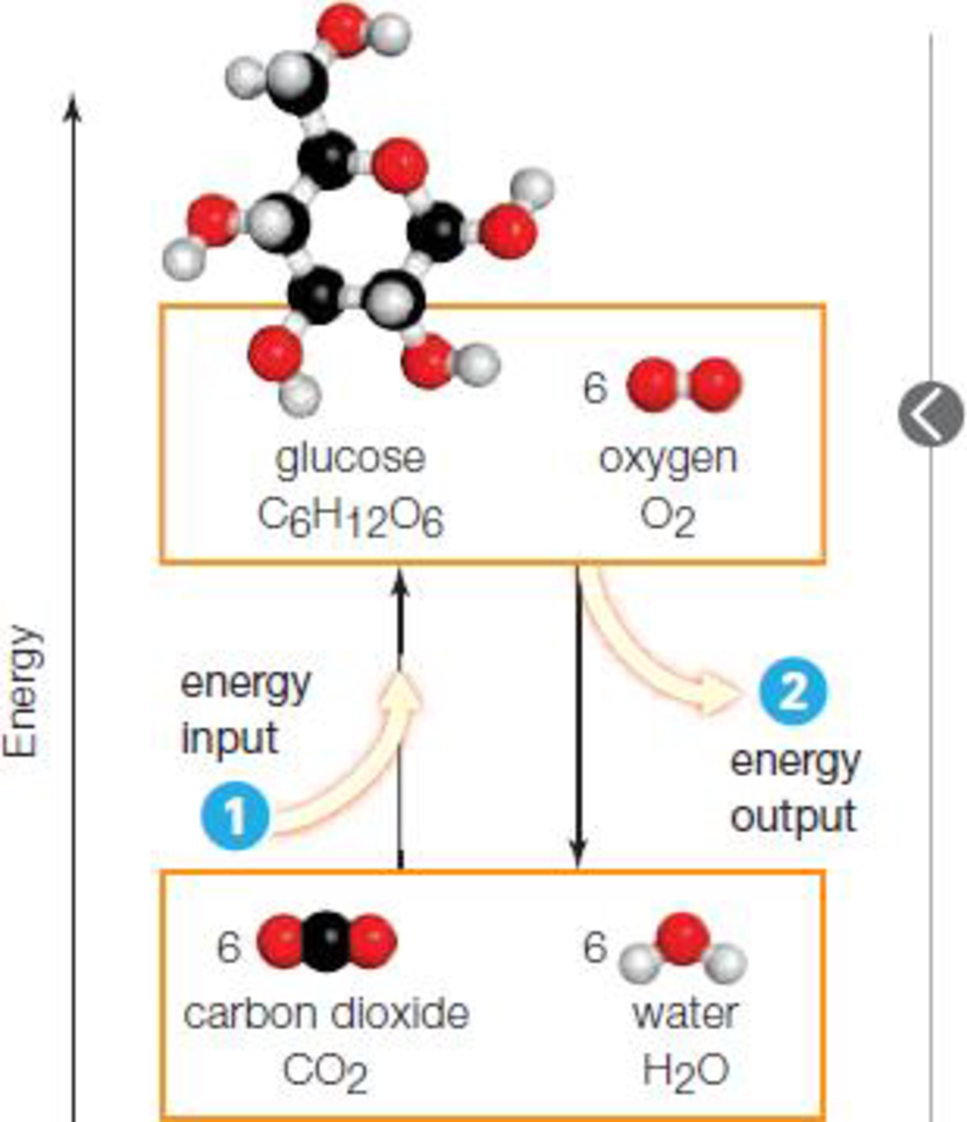
Concept explainers
Figure 4.5 Energy inputs and outputs in

- 1 Some reactions convert molecules with lower energy to molecules with higher energy, so they require a net energy input in order to proceed.
- 2 Other reactions convert molecules with higher energy to molecules with lower energy, so they end with an energy release
Figure It Out: Which law of
To determine: The law of thermodynamics that explains the energy inputs and outputs in chemical reaction.
Introduction: Thermodynamics is defined as the study of heat as well as other forms of energy. In the term thermodynamics, therm indicates heat and dynam indicates power. The first law of thermodynamics states that energy can neither be created nor destroyed. The second law of thermodynamics states that the energy can spread out spontaneously.
Explanation of Solution
The first law of thermodynamics explains the energy inputs and energy outputs in the chemical reactions. The first law of thermodynamics is also called as the law of conservation of energy and it states that the energy can neither be created nor destroyed. The total amount of energy that is present before and after conversion remains the same. If the energy present in reactants is less than the product, then the reaction will proceed only with the net energy input. If the energy of the reactant is higher than the product, the reaction ends with a net energy release.
In the given figure, a lower energy molecule is converted to a higher energy molecule and for the reaction to proceed, it requires net energy input. In the other reaction, higher energy molecule is converted to the lower energy molecule with a net energy release. Thus, the first law of thermodynamics explains the input and output of energy in the given chemical reactions.
Want to see more full solutions like this?
Chapter 4 Solutions
Biology Today and Tomorrow without Physiology (MindTap Course List)
- 22. Which of the following mutant proteins is expected to have a dominant negative effect when over- expressed in normal cells? a. mutant PI3-kinase that lacks the SH2 domain but retains the kinase function b. mutant Grb2 protein that cannot bind to RTK c. mutant RTK that lacks the extracellular domain d. mutant PDK that has the PH domain but lost the kinase function e. all of the abovearrow_forwardWhat is the label ?arrow_forwardCan you described the image? Can you explain the question as well their answer and how to get to an answer to an problem like this?arrow_forward
- Describe the principle of homeostasis.arrow_forwardExplain how the hormones of the glands listed below travel around the body to target organs and tissues : Pituitary gland Hypothalamus Thyroid Parathyroid Adrenal Pineal Pancreas(islets of langerhans) Gonads (testes and ovaries) Placentaarrow_forwardWhat are the functions of the hormones produced in the glands listed below: Pituitary gland Hypothalamus Thyroid Parathyroid Adrenal Pineal Pancreas(islets of langerhans) Gonads (testes and ovaries) Placentaarrow_forward
 Biology Today and Tomorrow without Physiology (Mi...BiologyISBN:9781305117396Author:Cecie Starr, Christine Evers, Lisa StarrPublisher:Cengage Learning
Biology Today and Tomorrow without Physiology (Mi...BiologyISBN:9781305117396Author:Cecie Starr, Christine Evers, Lisa StarrPublisher:Cengage Learning Biology 2eBiologyISBN:9781947172517Author:Matthew Douglas, Jung Choi, Mary Ann ClarkPublisher:OpenStax
Biology 2eBiologyISBN:9781947172517Author:Matthew Douglas, Jung Choi, Mary Ann ClarkPublisher:OpenStax Human Physiology: From Cells to Systems (MindTap ...BiologyISBN:9781285866932Author:Lauralee SherwoodPublisher:Cengage Learning
Human Physiology: From Cells to Systems (MindTap ...BiologyISBN:9781285866932Author:Lauralee SherwoodPublisher:Cengage Learning Biology: The Dynamic Science (MindTap Course List)BiologyISBN:9781305389892Author:Peter J. Russell, Paul E. Hertz, Beverly McMillanPublisher:Cengage Learning
Biology: The Dynamic Science (MindTap Course List)BiologyISBN:9781305389892Author:Peter J. Russell, Paul E. Hertz, Beverly McMillanPublisher:Cengage Learning Biology (MindTap Course List)BiologyISBN:9781337392938Author:Eldra Solomon, Charles Martin, Diana W. Martin, Linda R. BergPublisher:Cengage Learning
Biology (MindTap Course List)BiologyISBN:9781337392938Author:Eldra Solomon, Charles Martin, Diana W. Martin, Linda R. BergPublisher:Cengage Learning





